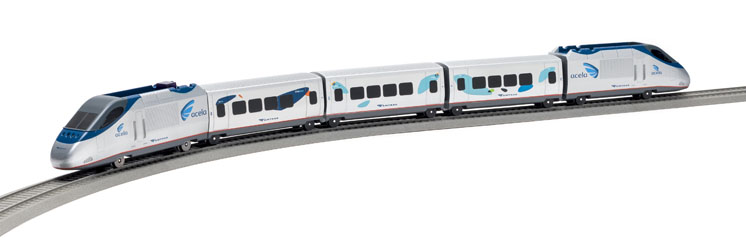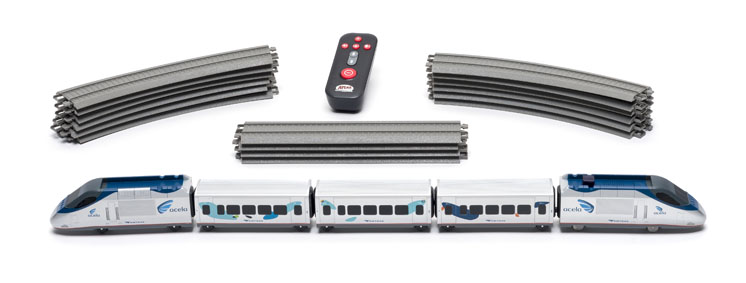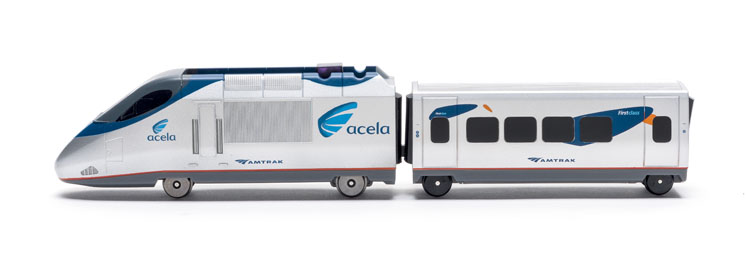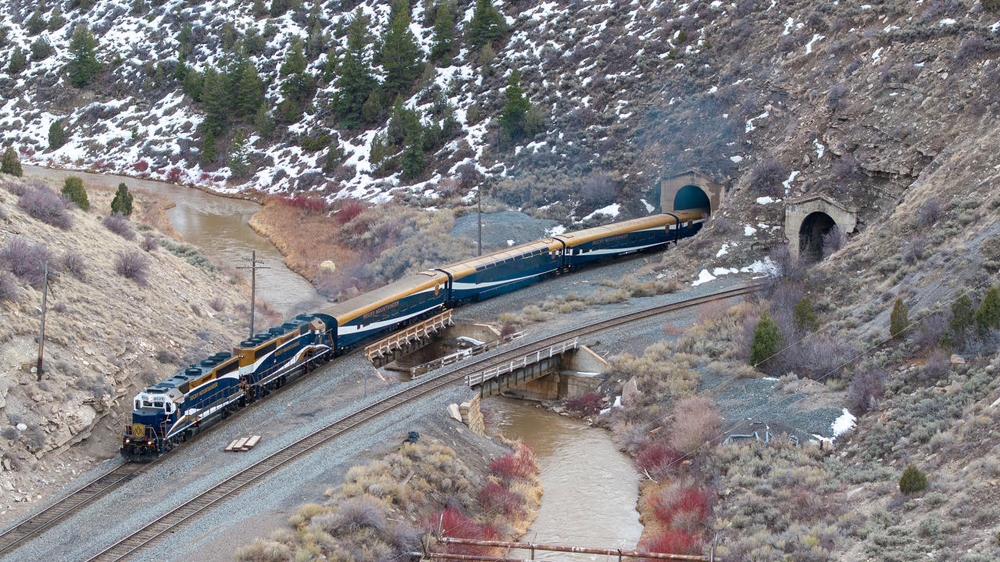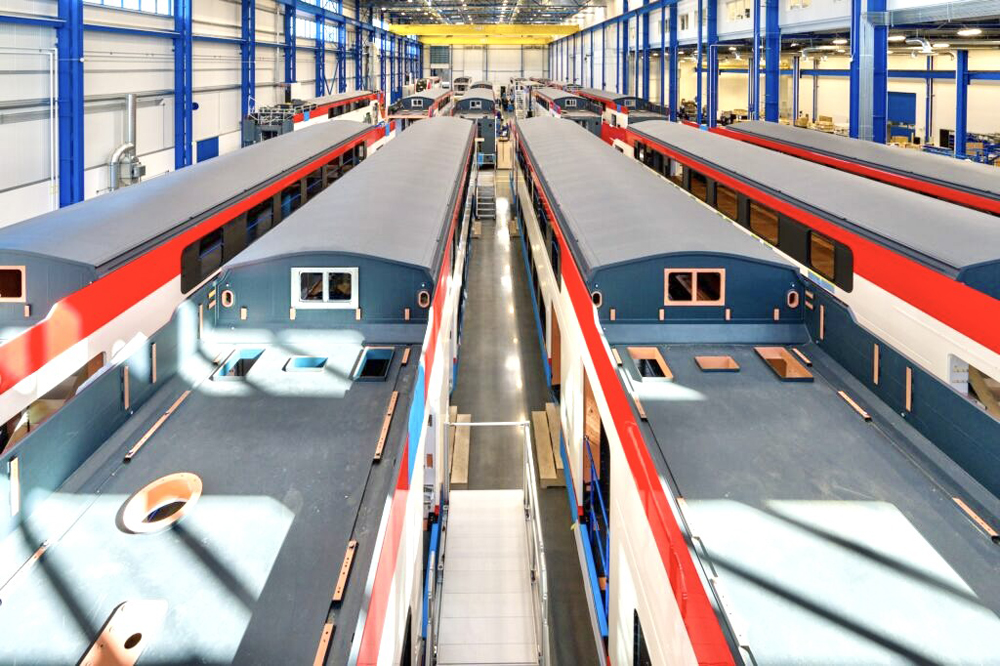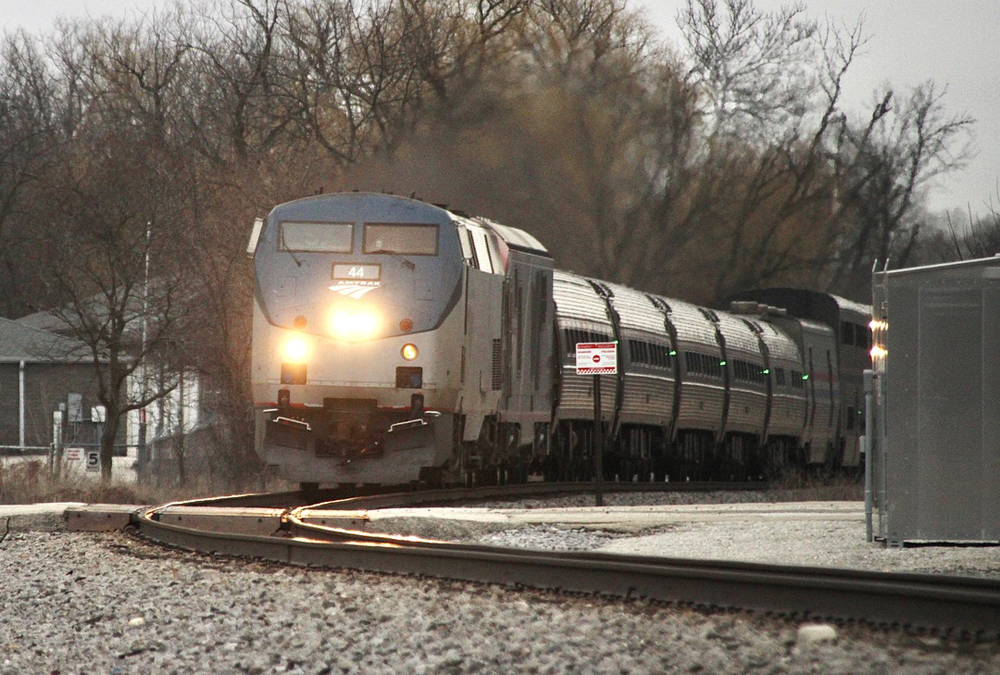Atlas Model Railroad Co. hopes to recruit a new generation of hobbyists into model railroading with its new Trainkids line. The first offering under this new brand is a passenger train set inspired by Amtrak’s high-speed Northeast Corridor train, the Acela Express. The set comes with a battery-powered locomotive/first-class car set, two more passenger cars, and a dummy trailing locomotive; a wireless remote control with direction, speed, sound, and lighting controls; and an oval of snap-together plastic track, ready to set up on the kitchen table or under the Christmas tree in minutes.
But this is more than just a toy; it’s designed to be a steppingstone, filling the gap between fanciful steam engines with smiling faces on their smokeboxes and prototypical scale models. Although the locomotive and cars aren’t to scale – they’re foreshortened and have only four wheels each – they’re depicted realistically, not cartoonishly. And best yet, the flanged wheels are gauged for HO scale track, so a youngster who starts out with this set can run them on dad’s HO layout, then graduate to scale model trains.
Appearance. The set is eye-catching, with bright silver paint and the abstract multicolor blobs of Amtrak’s Acela paint scheme (which Amtrak calls “mobiles”). As I mentioned before, the cars aren’t to scale and therefore the paint schemes can’t be, either. But they are fairly faithful to the original schemes, and it’s possible to identify the different classes of car by the colors and placement of the mobiles. The paint is smooth and evenly applied, and the printing is crisp and straight; the tiny “Welcome” printed next to each door isn’t quite legible under magnification. The windows aren’t see-through, but rather, molded into the bodies and painted black.
The cars seem rugged, with one-piece bodies molded in high-impact plastic and wheels with sturdy metal axles. They ought to stand up to rough play. (What kid doesn’t like to see trains crash?)
Instead of couplers, the cars are joined by magnets. They’re housed in slightly curved, pivoting black rectangles, mounted where there should be end doors. When the cars are joined, these give the appearance of being diaphragms. It seems like the magnets are mounted to move freely inside these pseudo-diaphragms, since no matter which way I oriented the cars to each other – even turning one upside down – the magnets still engaged and stuck. That’s one less potential source of frustration for little engineers.
Battery control. Eliminating the awkwardness of stringing wires across the floor and under the roadbed, Atlas made this train set battery powered, with a wireless remote control. The engine is powered by four AA batteries (not included). These fit into a battery holder that screws into the bottom of the first class car, which is permanently drawbar-coupled to the locomotive. The locomotive contains the motor, control circuitry, a speaker, light-emitting diode headlights, and the infrared receiver for the remote control. The power button is on top of the locomotive.
While the wheels on the battery car and all trailing cars are plastic, the locomotive’s wheels are blackened metal. The ones on the locomotive’s left side are insulated from the axle, which means it can be run on a powered layout without creating short circuits. The motor drives only the locomotive’s rear wheels, which have rubbery traction tires.
The remote control works out to a range of about 10 feet and doesn’t need a direct line of sight if the infrared beam can bounce off the ceiling or wall. It has four small red pushbuttons at the top, labeled with universal icons, to control the headlights, horn, bell, and “welcome aboard” announcement. Below them is a gray up-down rocker switch to control the speed; the locomotive has three speed settings in each direction, forward and backward. At the bottom is a large red stop button to stop the locomotive immediately.
On both the remote and the bottom of the locomotive is a small toggle labeled “A-B.” This chooses which channel the remote and locomotive communicate on. Selecting opposite settings would let you run two Atlas Trainkids train sets independently.
The remote needs two AAA batteries (also not included). When I removed the screw that holds the battery cover on, I heard something click inside. The nut that engages the cover screw had fallen off and was rattling around loose. In order to reattach the battery cover, I had to disassemble the halves of the remote, tape the nut in place, then reassemble it.
The track. Even though each section is a single piece of gray plastic, it’s finely molded and detailed well, with a rocky ballast texture, wood-grained ties, and tie plate and spike head detail on each tie. Mold lines and ejection pins were confined to the bottom of the sections. A little paint wash and drybrushing to make it look even more realistic might be a fun parent-child project to introduce the little one to the wonders of weathering. And since the locomotive is battery-operated, it doesn’t matter if a little paint gets on the railhead.
The sixteen track sections – twelve 30-degree 18″-radius curves and four 9″ straight sections, which assemble into a 38″ x 56″ oval – snap together precisely, with the joint hardly visible. Joining the sections might be a little tricky for those on the lower end of the recommended 4-and-up age range, but a second-grader should have no problem figuring it out.
The connectors on the ends of each section look a little fragile, but with the way they’re designed, if a section is bent upward at a joint, it merely comes apart rather than breaking. That ought to save some headaches down the road. (Bending the track down would still be a bad idea, though.
The only thing this track doesn’t have that I’d like to see is drill points or bosses for permanently tacking it down to a tabletop. But I suppose that when a kid is ready for that, he’s ready for Atlas True-Track, anyway.
Off to the test track. I assembled the curved sections of track on my office floor and placed the locomotive and cars on the rails. After pressing the power button, I tested the lights and sound effects, then set it going at medium speed. I intended to let it go until the batteries died to test the battery life, but it turns out Atlas was too smart for me. The engine automatically shuts off after an hour of continuous running to save the battery. (Any kid who lets the train run for an hour without touching the remote isn’t paying attention, anyway.)
Just for fun I also set the train up on the Milwaukee, Racine & Troy, our HO scale staff railroad. The Trainkids track sets available don’t include turnouts (yet), but I wanted to see how the set handled them. The no. 5 turnouts in Bay Junction Yard presented no difficulty, forward or backward, even at high speed. (High speed is quite speedy on this train, by the way – no doubt to appeal to kids who like to see ’em go fast.) And the little engine that could, did, successfully climbing the curving 3 percent grade to Skyridge without hesitation at medium speed. (The drive wheels slipped at low speed, though.)
Lowering the barriers to entry. I like to call trains like this set “gateway” models, because they’re designed to get impressionable young newcomers hooked on the hobby. It’s easy to set up and run and is practically foolproof. And despite its necessary trade-off of scale fidelity in favor of durability, economy, space, and play value, there’s enough realism in this set to get a kid jonesing for a scale model of his or her own. Can you say “prototype,” boys and girls? I knew you could.
Price: Train set, $99.95; add-on powered locomotive and first-class battery car, $49.95; add-on business class car, $13.95; figure-8 track expansion pack, $29.95
Manufacturer
Atlas Model Railroad Co.
378 Florence Ave.
Hillside, NJ 07205
atlastrainkids.com
Road names: Amtrak
Era: 2000 to present
Features
• 16 segments of molded plastic track with roadbed (assembles into 38″ x 56″ oval)
• Ages 4 and up
• Blackened metal wheels on locomotive (plastic wheels on unpowered cars), all in gauge
• Infrared remote control
• Light-emitting diode lighting on powered locomotive
• Magnetic diaphragm coupling
• Powered locomotive/first-class car combo
• Unpowered trailing locomotive, diner car, and business class car





